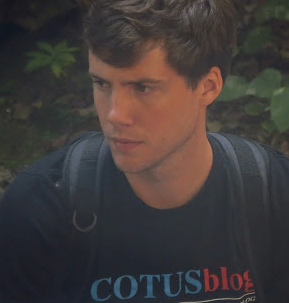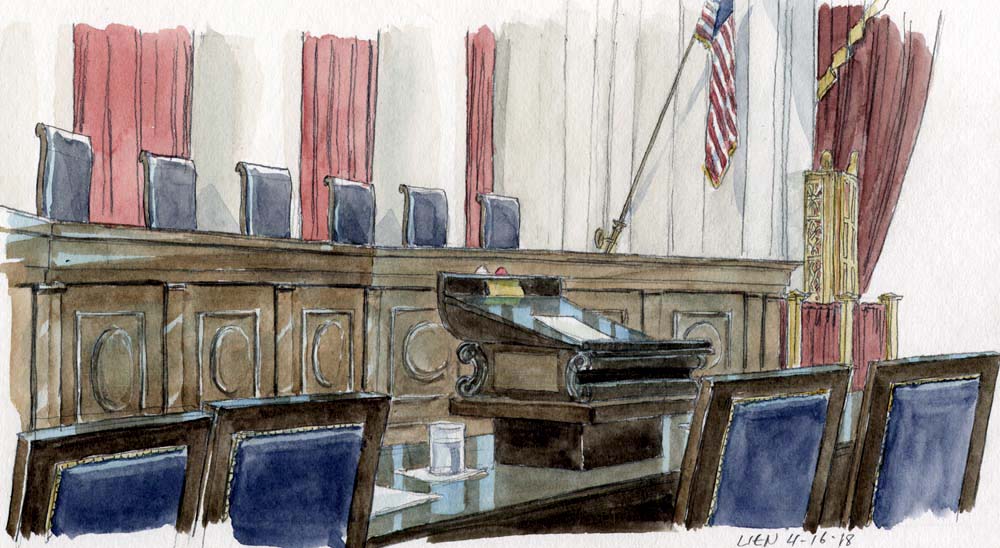Constitutional interpretation and Loving v. Virginia (Corrected)

on May 10, 2018 at 1:31 pm

“How would each of you have decided Loving v. Virginia?”
Justice Ruth Bader Ginsburg put this question to scholars Richard Primus and Randy Barnett on Tuesday at the Supreme Court, interrupting their debate over modes of constitutional interpretation. According to Jennifer Lowe, the director of programs at the Supreme Court Historical Society, it’s the first time a justice has spoken up at one of these events.
Loving is a 1967 decision in which the Supreme Court held that Virginia’s anti-miscegenation law violated the equal protection clause of the 14th Amendment. Ginsburg has called Loving “one of the most important decisions” in history, “as important, if not more important, than Brown v. Board of Education,” “the one that, more than anything else, was meant to end apartheid in America.”
Primus began his answer with “a plea for humility as we think about history.” “It’s so easy to think, ‘well, of course I would have done the right thing,’” he said, but “we don’t know what we would have done.”
“If the question is about who I am today,” Primus continued, “my view would be that by the time of Loving, we have the equal-protection principle of Brown. The law in Loving made the criminality of an act depend on the race of the actor, and it just follows from the principle of Brown and equal protection that that can’t be.”
Earlier in the debate, Primus had called himself a common-law constitutionalist. Under his theory, “where decision-making by courts is concerned, precedent is the best guide to constrained discretion of judges, to hold the legal system stable, to let people order their affairs.” “It does not succeed in completely eliminating discretion and judgment calls,” he admitted; “no sane theory of adjudication does.”
For his part, Barnett defended public-meaning originalism, the theory that “the meaning of the text of the Constitution should remain the same until it’s properly changed by amendment.” He contrasted his approach with other theories of originalism based on the framers’ intentions for a particular amendment or on expectations by the public for how an amendment would be applied. Public-meaning originalism requires extensive historical investigation, but not, unlike other types of originalism, “impossible” counter-factual inquiries.
Barnett criticized Primus’ response to Ginsburg’s question. “I think on Richard’s approach, it’s very difficult to know why Loving wouldn’t have come out the other way before Brown.” “Without Brown being decided, then Loving is obviously wrong,” Barnett continued, because “legal practice and precedent said [Virginia’s law] was constitutional and so it must have been constitutional.”
Under Primus’ approach, Barnett suggested, anti-miscegenation laws “only became unconstitutional … 13 years after 1954,” when Brown was decided. But “if Loving is correctly decided, as it clearly is, in my view,” Barnett argued, “it’s because it was unconstitutional the day the 14th Amendment was enacted,” in 1868.
“Just because people back then didn’t think it was irrational” for a state to pass anti-miscegenation laws, Barnett continued, “doesn’t mean that it was rational” under the actual text of the 14th Amendment. “That was true in 1868 and it was true all the way through,” Barnett said; “it’s only people’s opinions about whether it was irrational that have changed, not the Constitution itself.”
Primus observed that the Supreme Court in the 1883 case Pace v. Alabama unanimously upheld a law restricting interracial marriage, 15 years after the passage of the 14th Amendment. “I’m fine with the proposition that the content of the law at the time of Pace was morally objectionable,” Primus suggested. “I have a difficult time with the idea that for decades and decades the whole legal profession can just be wrong about what its law is.”
Countering this characterization of the 19th-century views of the legal profession, Barnett observed that some justices did dissent from certain incorrect decisions — notably Chief Justice Salmon Chase, who dissented from Bradwell v. Illinois, an 1873 decision upholding Illinois’ ability to deny law licenses to women, and Justice John Marshall Harlan, who dissented from Plessy v. Ferguson, an 1896 decision upholding Louisiana’s statute requiring separate accommodations for blacks and whites on railway cars.
Throughout the debate, Barnett attempted to distinguish between interpretation and application. “People make mistakes in the application phase,” and “it’s entirely possible for judges to be wrong,” even for decades. “Mostly what courts do,” Barnett had explained earlier, “is apply the doctrines they’ve developed in the past to implement the meaning of the text.” “That is your true living Constitution,” Barnett said, employing a term often used in contrast with originalism, “the living Constitution is how doctrines that have been developed to implement the Constitution have evolved over time.” “They’re only to be reconsidered,” he asserted, “if it’s established that they are somehow undercutting or inconsistent with or not faithful to both the letter and the spirit of the original Constitution.”
Barnett called for “an intellectual division of labor” between historians and judges. It’s “not realistic” that judges do the historical research required under public-meaning originalism, which should be accomplished by historians from law schools, history departments and outside the academy. Barnett noted that “in major cases that have been decided in the last five or 10 years that concern the original meaning of the Second Amendment, the right to keep and bear arms, and the original meaning of the recess appointments clause, justices don’t have to originate their own research. They rely on research that’s been done by others.”
Primus disagreed about the proper roles of judges and historians. “I think judges should mostly do the thing that is the core skill of appellate lawyers, which is reading cases and applying precedent,” he asserted. “It’s the thing that the system is built for them to do. It’s one of the features of our system, that the people who are asked to make those decisions are trained in those skills as lawyers and not as historians.”
“The Constitution is a kind of sacred text,” Primus continued; “its meaning is likely to be Protean when it matters in ways that has also been true of some other sacred texts.” “We will never stop running out of constitutional disagreements with each other,” he predicted.
Ginsburg did not comment on each professor’s answers to her question. She will be back in the courtroom on Monday for orders and possibly opinions.
An earlier version of this post suggested that Ginsburg had spoken over a speaker. She spoke up after he finished his sentence.


